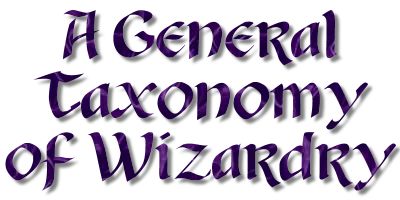| It
is impossible to embark upon a comprehensive taxonomy of wizardry
without first defining the various types of wizards, since wizards
themselves define the taxonomy. Before embarking on any
serious study of various magical types, a wizard must first define
that which s/he is and come to a better understanding of that
particular type.
Strictly speaking, there are four different
types of wizards: Adepts, Bards, Druids, and Mystics.
Adepts and Bards are considered to be "occultists," or
evocators, while Druids and Mystics are considered to be
esotericists, or invocators. All branches of wizardry may be
combined under these four top-level groups.
The term "pseudomagic" is used to
denote commonly accepted areas of philosophical study that do not
fall under, and should most definitely not be considered
"true" magic. Although some of these areas are
developing forms of modern magic, many of them are meretricious
expressions of philosophy, either as jokes or not to be taken
seriously. Others, such as Christianity and Wicca, may use
forms of that particular magical energy, but are more areas of
religious expression rather than magical practice.
|
|
| Adepts |
The Adept
is the wizard that is most concerned with outward manifestation of
magical energy. Most textbook wizards (the "pointed hat
and wand" variety) tend to fall into this category, although it
is not the predominant wizard type. Adepts tend to work
consciously with the manipulation of magic through the use of ritual
and ceremonial evocation. Adepts pull energy from the outer
world through their instruments, and relay it back to the outer world
in their manifestations. They are concerned with the form and style
of magical expression, and they glean their powers through focused
study and active ritual meditation. Adepts actively seek to
bring the unmanifest into physical expression, and are interested in
the mechanical process by which the unmanifest may be evoked.
They are most closely associated and aligned with the divine
energies of Fire/Color/Power.
Famous Adepts include: Henry Cornelius Agrippa, Alistair
Crowley, Dr. John Dee, Edward Kelly, Kung-Fu-Tse (Confucius),
Eliphas Levi, Theoprastus Paracelsus, and Austin Spare.
Types of Adept magic:
- Alchemy
- Chaos Magic
- Enochian
- Freemasonry
- Hermeticism
- Roscicrucianism
- Thaumaturgy
- Thelema
- Theurgy
Types of Adept pseudomagic:
- Discordianism
- Satanism
- Scientology
|
| Bards |
The Bard
is very much like an Adept in that both are more interested in
outward manifestation than inward embodiment of magical energy.
Their approaches to the magic are different, however. Bards
are interested in evoking magical energy by use of creative
techniques such as music, art, literary or dramatic expression,
scientific exploration, dance, structural design, sexual expression,
and education. In short, the Bard is most likely to work with
"Muse-ic" energy, and the Bard is most closely associated
with music and poetry. Bards pull energy from within
themselves and relay it into outer manifestation. They are
most closely associated and aligned with the divine energies of
Air/Sound/Harmony.
Famous Bards include: Ludwig Von Beethoven, William Blake,
William Burroughs, Salvadore Dali, Leonard Da Vinci, Benjamin
Franklin, Johannes Kepler, Marie Laveau, Michaelangelo, Wolfgang
Amadeus Mozart, Li Po, Arthur Edward Waite, Oscar Wilde, Frank Lloyd
Wright, and William Butler Yeats.
Types of Bardic magic:
- Dada
- Deco
- Diaspora (Voudoun)
- Kama Sutra
- Impressionism
- Parapsychology
- Surrealism
Types of Bardic pseudomagic:
- Phenomenology (UFOism)
- Tantra
|
| Druids |
The Druid
is most interested in working with the existing, natural energies of
Earth and the Universe, rather than evoking new manifestations such
as the Bard and Adept do. Druids are much less hung up on a
particular process and are focused on obtaining end results and
solutions to existing problems. Thus, the Druid is the most
versatile of all the various wizard types. Druids love all
true natural manifestations, including mineral, plant, and animal
Life, and work diligently to embody the natural process within their
own invocations. Druids pull energy from the outer world of
form through their own equipment and embody it in their own internal
sturucture, generally for healing themselves, others, or the natural
world. They are most closely associated and aligned with the divine
energies of Earth/Light.
Famous Druids include: Rachel Carson, Scott Cunningham,
Nicholas Copernicus, Galileo Galilei, Gerald Gardner, Dion Fortune,
S. Macgregor Mathers, John Muir, and Albert Schweitzer.
Types of Druid magic:
- Acupuncture/Accupressure
- Druidry
- Gaia Studies
- Geomancy
- Healing
- Reflexology
- Neopaganism
Types of Druid pseudomagic:
|
| Mystics |
The
Mystic, like the Druid, is concerned with working with the existing
energy structures. Mystics predominantly seek to glean meaning from
observable patterns in Nature, synthesize those into a greater
meaning, and relay the information back to the rest of creation.
Thus, the mystic pulls inner meaning from their won equipment, and
embodies it within themselves. Mystics tend to be the quietest and
most introspective of the wizards, as they tap into and help create
the vast repositories of information available to all of humanity.
They are most closely associated and aligned with the divine
energies of Water/Vibration/Love.
Famous Mystics include: Alice Bailey, H.P. Blavatsky,
Giordano Bruno, Edgar Cayce, Lucille Cedercrans, Jesus Christ,
Siddhartha Gautama, Manly Palmer Hall, Rudolf Steiner, and Lao Tse.
Types of Mystic magic:
- Divination
- Esoteric Studies
- Gnosticism/Gnostic Revival
- Kabbalah
- Taoism
- Theosophy
- Yoga
Types of Mystic pseudomagic:
- Buddhism
- Christianity
- EST
- Transcendental Meditation
|
|





